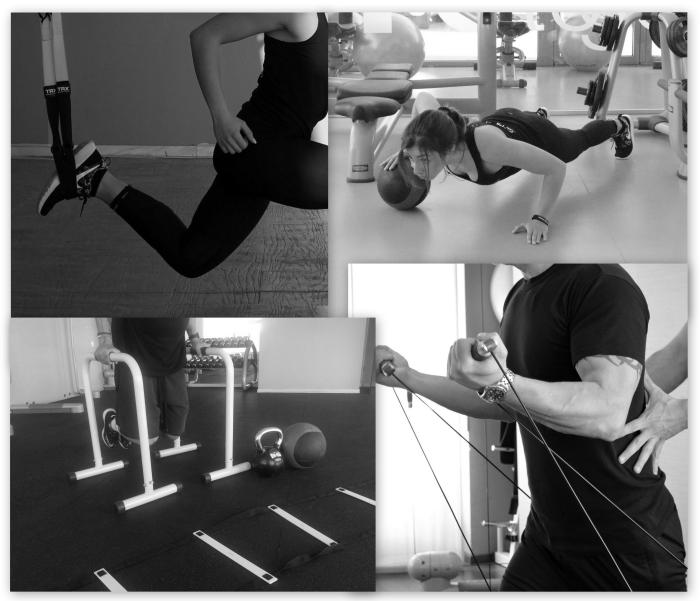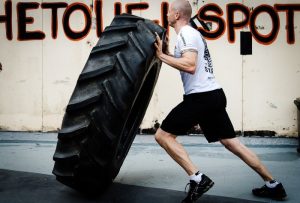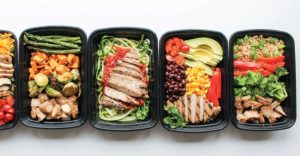
Forget dusty dumbbells and monotonous machines! Functional fitness training isn’t about isolating muscles; it’s about prepping your body for the real world. Think less “bicep curl” and more “lifting your toddler effortlessly” (or, you know, a slightly less adorable, but equally weighty, suitcase). We’re talking about movements that mimic everyday life, making you stronger, more agile, and less likely to spontaneously combust when faced with a flight of stairs.
This guide dives deep into the world of functional fitness, from beginner-friendly routines to advanced programs designed to turn you into a real-life superhero (minus the cape, unless you’re into that sort of thing). We’ll cover everything from proper form to injury prevention, ensuring you’re not just strong, but also smart about your training. Get ready to unlock your body’s full potential – one burpee at a time.
Defining Functional Fitness Training
Forget those bicep curls that only impress the mirror! Functional fitness is all about training your body for real-life activities. It’s about building strength and endurance that translates directly into your daily life, making everything from carrying groceries to chasing after a mischievous toddler a whole lot easier (and less likely to end in a dramatic, slow-motion fall).Functional fitness training focuses on movements that mimic real-world actions.
Instead of isolating individual muscles, it emphasizes compound exercises that work multiple muscle groups simultaneously, improving coordination, balance, and overall body control. The core principles revolve around improving functional strength, power, and endurance, with a strong emphasis on proper form and injury prevention. Think of it as training your body to be a well-oiled, efficient machine, rather than a collection of individually sculpted parts.
Core Principles of Functional Fitness Training
Functional fitness isn’t just about lifting heavy things; it’s about moving your body effectively and efficiently. Key principles include training movement patterns rather than isolating muscles, emphasizing compound exercises that mimic real-world actions, and focusing on proper form to prevent injuries. It’s about building a body that’s ready for anything life throws at it, from impromptu dance-offs to unexpectedly heavy suitcases.
Examples of Functional Fitness Exercises
Here are some common exercises found in functional fitness programs: Squats (mimicking sitting and standing), lunges (walking and stair climbing), push-ups (pushing movements), rows (pulling movements), planks (core stability), deadlifts (lifting heavy objects), and kettlebell swings (dynamic movements). These exercises engage multiple muscle groups and improve coordination, balance, and overall strength. Imagine a superhero training montage, but instead of punching robots, they’re perfecting their squat form.
Functional Fitness vs. Traditional Weight Training
While traditional weight training focuses on isolating specific muscles to build size and strength, functional fitness prioritizes movements and their application to real-world scenarios. Traditional weight training might involve bicep curls and tricep extensions, while functional fitness would incorporate exercises like pull-ups and push-ups that work multiple muscle groups at once. Both approaches have value, but functional fitness emphasizes practical application and overall body functionality.
Think of it this way: traditional weight training builds the individual parts of a car, while functional fitness builds the entire car, ready to drive.
Benefits of Functional Fitness for Everyday Life
The benefits of functional fitness extend far beyond the gym. Improved balance reduces the risk of falls, stronger core muscles improve posture and reduce back pain, increased flexibility makes daily tasks easier, and enhanced coordination improves overall physical performance. Imagine effortlessly carrying groceries up the stairs, playing with your kids without getting winded, and confidently navigating any obstacle life throws your way.
It’s about building a body that’s not just strong, but also resilient and adaptable to the demands of everyday life. Essentially, it’s the ultimate life hack for a healthier, happier, and more active you.
Functional Fitness Training Programs
Designing a functional fitness program isn’t about becoming a superhuman; it’s about building a body that works
- for* you, not just
- in* a gym. We’re talking about movements that translate into real-life activities – think effortlessly carrying groceries, playing with your kids, or even escaping a zombie apocalypse (we all need a plan, right?). This means focusing on compound exercises that work multiple muscle groups simultaneously, improving your overall strength, balance, and coordination.
Beginner Functional Fitness Program: Bodyweight Basics
This program emphasizes proper form over quantity. Remember, quality over quantity is key! Start slowly, listen to your body, and gradually increase repetitions and sets as you get stronger. Consistency is your superpower here.
- Warm-up (5 minutes): Jumping jacks, high knees, arm circles, dynamic stretches like leg swings.
- Workout (20-30 minutes):
- Squats: 3 sets of 10-12 repetitions. Imagine sitting down in a chair without actually using one.
- Push-ups (on knees if needed): 3 sets of as many repetitions as possible (AMRAP).
- Lunges (alternating legs): 3 sets of 10-12 repetitions per leg. Picture yourself striding purposefully through a field of sunflowers.
- Plank: Hold for 30 seconds, 3 sets. Imagine you’re a perfectly rigid plank of wood, unyielding and strong.
- Glute bridges: 3 sets of 15-20 repetitions. Feel the power in your glutes as you lift your hips.
- Cool-down (5 minutes): Static stretches, holding each stretch for 30 seconds. Think gentle hamstring stretches, quad stretches, and tricep stretches.
Intermediate Functional Fitness Program: Level Up
This program builds upon the beginner program, incorporating more challenging variations and adding resistance where appropriate. Remember to maintain good form, even as the intensity increases. Think of it as a game – each workout is a level, and you’re constantly upgrading your abilities.
- Warm-up (5-7 minutes): More dynamic stretches, including jumping jacks with arm variations, lateral bounds, and torso twists.
- Workout (45-60 minutes):
- Goblet squats (holding a dumbbell or kettlebell): 3 sets of 10-12 repetitions. The added weight makes it more challenging, but maintain proper form.
- Incline push-ups (hands on a slightly elevated surface): 3 sets of AMRAP. This variation makes it slightly easier while still challenging your chest and triceps.
- Walking lunges with dumbbells: 3 sets of 10-12 repetitions per leg. Feel the burn in your legs and glutes as you add some resistance.
- Side plank (each side): Hold for 45 seconds, 3 sets per side. Engage your core and obliques for maximum stability.
- Single-leg glute bridges: 3 sets of 12-15 repetitions per leg. This variation increases the challenge by requiring more balance and core stability.
- Burpees: 3 sets of 10 repetitions. This full-body exercise is a great way to increase your cardiovascular fitness and strength.
- Cool-down (5-7 minutes): Static stretches, holding each stretch for 45 seconds. Include more challenging stretches to increase flexibility.
Progressive Overload in Functional Fitness: The Key to Growth
Progressive overload is the cornerstone of any successful fitness program. It simply means consistently challenging your body by gradually increasing the intensity or volume of your workouts over time. This could involve increasing the number of repetitions, sets, or the weight you lift, or by incorporating more challenging variations of exercises. Think of it as a slow and steady climb up a mountain – each step is small, but together they lead to incredible progress.
For example, if you can comfortably do 10 squats, aim to do 12 next week, then 15 the week after. Don’t rush the process; consistency and gradual increases are key. Ignoring progressive overload is like trying to build a house with only toothpicks – it might look impressive initially, but it won’t last.
Safety and Injury Prevention in Functional Fitness

Functional fitness, while fantastic for building real-world strength and agility, isn’t a free pass to ignore your body’s pleas for mercy. Like a mischievous puppy, it can be incredibly rewarding, but also prone to the occasional (or not-so-occasional) mishap if not handled with care. Understanding the risks and implementing preventative measures is key to enjoying the benefits without ending up sidelined with an injury.
Let’s dive into how to keep your functional fitness journey safe and injury-free.Common Injuries Associated with Functional Fitness Training are often related to overuse, improper form, or insufficient warm-up. Think of it like this: your body is a finely tuned machine, and neglecting proper maintenance can lead to breakdowns. Ignoring proper form while performing a squat, for instance, can lead to knee pain, while neglecting your warm-up before a high-intensity workout might result in a pulled muscle.
The good news is that many injuries are preventable with the right approach.
Common Functional Fitness Injuries
Overuse injuries, such as tendinitis (inflammation of a tendon) and bursitis (inflammation of a bursa, a fluid-filled sac that cushions joints), are frequent culprits. These often arise from repetitive movements without adequate rest. Muscle strains and sprains, resulting from sudden or forceful movements, are also common, particularly in exercises involving quick changes in direction or heavy weights. Finally, lower back pain, often stemming from poor posture or incorrect lifting techniques, is a prevalent concern in functional fitness programs.
Imagine trying to lift a heavy box without bending your knees – disaster waiting to happen!
Strategies for Proper Form and Technique
Maintaining correct form is paramount to injury prevention. It’s about precision, not just power. Think of a perfectly executed squat: your back should remain straight, knees aligned with your toes, and your core engaged. Similarly, a proper deadlift involves a neutral spine, engaging your legs, and avoiding rounding your back. Visualize a straight line from your head to your heels throughout the movement.
If you’re unsure about proper form, seek guidance from a qualified fitness professional. They can provide personalized feedback and ensure you’re performing exercises correctly. Consider recording yourself to identify areas for improvement. Remember, perfect form is your best defense against injury.
The Crucial Role of Warm-up and Cool-down Routines
Think of your warm-up as preparing your car engine before a long drive. You wouldn’t just jump in and floor it, would you? A proper warm-up increases blood flow to muscles, increases joint mobility, and prepares your body for the physical demands of the workout. Dynamic stretches, like arm circles and leg swings, are ideal. Similarly, a cool-down helps your body gradually transition back to a resting state, reducing muscle soreness and promoting recovery.
Static stretches, holding a stretch for 15-30 seconds, are beneficial here. A good rule of thumb is to spend at least 5-10 minutes warming up and 5-10 minutes cooling down.
Modifications for Individuals with Pre-existing Conditions
Functional fitness isn’t a one-size-fits-all approach. Individuals with pre-existing conditions, such as arthritis, back pain, or previous injuries, require tailored modifications. For example, someone with knee problems might need to modify squats by reducing the depth or using a chair for support. A person with back pain might benefit from avoiding exercises that involve excessive spinal flexion or extension.
Collaboration with a physical therapist or healthcare professional is crucial to design a safe and effective program that accommodates individual needs and limitations. Remember, adapting exercises doesn’t mean compromising on results; it simply means prioritizing safety and individual well-being.
Functional Fitness and Specific Populations
Functional fitness isn’t just for CrossFit fanatics and Instagram influencers; it’s a philosophy that can benefit everyone, regardless of age, fitness level, or athletic aspirations. Tailoring functional fitness programs to specific populations requires a nuanced understanding of their unique needs and limitations, ensuring safety and maximizing results. We’ll explore how to adapt functional fitness for older adults, those recovering from injury, athletes seeking peak performance, and even expectant mothers.
Functional Fitness for Older Adults
Maintaining functional fitness in later life is crucial for independence and quality of life. This program focuses on building strength, balance, and flexibility, all essential for navigating daily activities with ease. Exercises should be low-impact, focusing on controlled movements and proper form.
A sample program could include:
- Chair squats: Builds lower body strength without the stress of a full squat. Imagine slowly sitting down and standing up from a chair, maintaining good posture.
- Wall push-ups: Modifies traditional push-ups for easier execution, focusing on upper body strength and stability. Picture leaning against a wall, arms slightly bent, and slowly pushing away.
- Heel raises: Improves calf strength and ankle stability, crucial for balance and preventing falls. Think about slowly lifting up onto your toes, holding for a second, then slowly lowering.
- Tai Chi or Yoga: These practices enhance balance, flexibility, and coordination, contributing to overall functional fitness. Visualize slow, controlled movements with deep breathing.
Remember, progression should be gradual, prioritizing safety over speed. Always consult a physician before starting any new exercise program.
Rehabilitation After Injury
Recovering from an injury requires a carefully designed functional fitness program focusing on restoring strength, range of motion, and stability. The program should be tailored to the specific injury and the individual’s recovery stage, progressing gradually to avoid re-injury.
For example, after a knee injury, the program might start with:
- Range of motion exercises: Gentle movements to regain full knee flexion and extension. Imagine slowly bending and straightening your knee.
- Isometric exercises: Strengthening muscles without joint movement, reducing stress on the injured area. Think of holding your leg straight out in front of you for a count of ten.
- Light weight training: Gradually increasing resistance to build muscle strength around the knee joint. Imagine doing leg presses with very light weights.
- Balance exercises: Improving stability and coordination, crucial for preventing future injuries. Picture standing on one leg for short periods.
Close collaboration with a physical therapist is essential for safe and effective rehabilitation.
Functional Fitness for Athletes
For athletes, functional fitness enhances performance by improving strength, power, speed, agility, and flexibility. The program should be sport-specific, addressing the demands of the athlete’s chosen discipline.
A basketball player, for example, might benefit from:
- Plyometrics: Explosive movements like box jumps to improve jumping ability. Imagine jumping onto a box, landing softly, and repeating.
- Agility drills: Cone drills and lateral movements to enhance quickness and change of direction. Picture running through a series of cones, changing direction rapidly.
- Strength training: Focusing on compound movements like squats, deadlifts, and presses to build overall strength. Imagine performing a squat with a barbell on your back.
- Core work: Strengthening the core muscles for stability and power generation. Think of planks and Russian twists.
The program should be periodized, varying intensity and volume throughout the training cycle to optimize performance and prevent overtraining.
Functional Fitness Exercises for Pregnant Women
Maintaining fitness during pregnancy offers numerous benefits for both mother and baby. However, modifications are necessary to accommodate the changing body and avoid potential risks. The focus should be on low-impact exercises that promote strength, endurance, and flexibility.
Safe exercises include:
- Modified squats: Maintaining a wide stance for better balance and stability. Imagine doing a squat with feet wider apart.
- Walking: A low-impact cardio exercise that improves cardiovascular health. Picture a brisk walk in a park.
- Swimming: Excellent for low-impact cardio and strengthening various muscle groups. Imagine swimming laps in a pool.
- Prenatal yoga: Enhances flexibility and prepares the body for childbirth. Imagine gentle stretches and breathing exercises.
Always consult a physician or certified prenatal fitness instructor before starting any exercise program during pregnancy.
Measuring Progress and Results in Functional Fitness
Tracking your progress in functional fitness isn’t just about bragging rights (though that’s a nice perk!). It’s about seeing how far you’ve come, identifying areas needing improvement, and staying motivated on your fitness journey. Think of it as a personalized adventure map, charting your climb to peak physical prowess!Progress tracking in functional fitness relies on a multifaceted approach, combining objective measurements with subjective feedback.
We’re not just looking at numbers here; we’re interested in the overall improvement in your ability to perform everyday tasks with ease and efficiency.
Methods for Tracking Progress
Several methods can be used to monitor your progress. Regularly recording your performance in various exercises, noting changes in your body composition, and monitoring your overall energy levels are all vital aspects of tracking your journey. Consider using a combination of methods for a comprehensive overview. Don’t just focus on the numbers; listen to your body and how it feels performing these movements.
Metrics for Assessing Fitness Components
Strength, endurance, and flexibility are the cornerstones of functional fitness. Let’s look at how we can measure improvements in each area.
Strength Metrics
Measuring strength involves assessing your ability to overcome resistance. This could be through bodyweight exercises (like push-ups or squats), resistance band exercises, or weight training. We can track improvements by recording the number of repetitions you can perform with a given weight or resistance level, the amount of weight you can lift for a specific number of repetitions (1RM – one repetition maximum), or the time you can hold an isometric contraction.
For example, tracking your maximum number of unassisted pull-ups over time provides a clear indicator of strength gains.
Endurance Metrics
Endurance focuses on sustaining effort over time. For functional fitness, this might involve assessing how long you can perform a specific exercise (like planks or wall sits), the distance you can cover while carrying a weight, or your performance in longer duration activities such as running or cycling. For instance, noting the duration of your daily walk/run and comparing it to previous weeks will showcase your endurance progress.
Flexibility Metrics
Flexibility refers to your range of motion. We can track this by measuring the distance you can reach in various stretches (like the sit-and-reach test), or by assessing your ability to perform movements that require a wide range of motion (like squats with a deep knee bend). Using a goniometer (a device used to measure angles) for specific joint ranges is a more precise method.
A simple but effective method is noting the difference in your ability to reach your toes over time.
Setting Realistic Goals and Expectations
Setting realistic goals is crucial. Avoid comparing yourself to others; focus on your personal journey. Start with small, achievable goals and gradually increase the challenge as you progress. Remember, consistency is key! A slow and steady approach is far more sustainable than pushing yourself too hard too soon, leading to burnout or injury. Think “marathon, not sprint.” For instance, aiming to increase your push-ups by one repetition each week is a more realistic goal than aiming for a 100% increase in one month.
Tracking Progress Over Time
Here’s a sample table to demonstrate how you can organize your data:
| Date | Exercise | Reps/Sets | Notes |
|---|---|---|---|
| 2024-03-08 | Squats | 3 sets of 10 reps | Felt good, good form |
| 2024-03-15 | Squats | 3 sets of 12 reps | Increased reps, slight fatigue |
| 2024-03-22 | Push-ups | 3 sets of 8 reps | Still working on form |
| 2024-03-29 | Push-ups | 3 sets of 10 reps | Improved form, increased reps |
Functional Fitness and Nutrition
Fueling your body for peak performance in functional fitness isn’t just about eating; it’s about optimizing your engine for maximum efficiency. Think of your workouts as a high-performance sports car – you wouldn’t put regular gas in a Ferrari, would you? Proper nutrition is the high-octane fuel that powers your muscles, repairs tissues, and keeps you feeling your best.
Neglecting this crucial element is like trying to win a race with flat tires.Proper nutrition plays a vital role in achieving optimal results in functional fitness. Adequate intake of macronutrients (protein, carbohydrates, and fats) and micronutrients (vitamins and minerals) is essential for muscle growth, recovery, energy production, and overall health. Without the right fuel, your workouts will suffer, your recovery will be sluggish, and your progress will plateau.
This isn’t just about aesthetics; it’s about maximizing your physical capabilities and reducing your risk of injury.
Sample Meal Plan for Functional Fitness
This sample meal plan provides a balanced intake of macronutrients to support a functional fitness training regime. Remember to adjust portion sizes based on your individual caloric needs and activity level. Consult a registered dietitian or nutritionist for personalized guidance.
| Meal | Food | Macronutrient Focus |
|---|---|---|
| Breakfast (7:00 AM) | Oatmeal with berries and nuts, Greek yogurt | Complex carbohydrates, protein, healthy fats |
| Mid-Morning Snack (10:00 AM) | Apple slices with almond butter | Fiber, healthy fats, protein |
| Lunch (1:00 PM) | Chicken salad sandwich on whole-wheat bread with a side salad | Lean protein, complex carbohydrates, fiber |
| Afternoon Snack (4:00 PM) | Protein shake with banana | Protein, carbohydrates |
| Dinner (7:00 PM) | Salmon with roasted vegetables and quinoa | Lean protein, healthy fats, complex carbohydrates |
Hydration and Recovery Strategies
Staying properly hydrated is crucial for performance and recovery. Dehydration can lead to fatigue, muscle cramps, and decreased performance. Aim to drink plenty of water throughout the day, especially before, during, and after your workouts. Consider adding electrolytes to your water, particularly during longer or more intense training sessions.Post-workout recovery is equally important. Replenishing glycogen stores (carbohydrates) and repairing muscle tissue (protein) are key.
Consuming a protein and carbohydrate-rich snack or meal within 30-60 minutes after your workout can significantly enhance recovery. Adequate sleep is also vital for muscle repair and overall well-being. Aim for 7-9 hours of quality sleep each night.
Dietary Approaches for Functional Fitness Athletes
Several dietary approaches can support functional fitness goals. A balanced diet emphasizing whole, unprocessed foods is a solid foundation. However, some athletes may benefit from more specific approaches:
- Mediterranean Diet: Rich in fruits, vegetables, whole grains, legumes, and healthy fats, this diet is associated with numerous health benefits and can support sustained energy levels and recovery.
- Paleo Diet: Focuses on whole, unprocessed foods that were available to early humans, emphasizing lean protein, fruits, vegetables, and healthy fats. This diet can be effective for some, but requires careful planning to ensure adequate micronutrient intake.
- Flexible Dieting: This approach allows for more flexibility in food choices while still meeting macronutrient targets. It can be particularly helpful for individuals who struggle with restrictive diets. However, it requires careful tracking and planning to ensure overall nutritional adequacy.
Remember, the best dietary approach is one that you can sustain long-term and that supports your individual needs and preferences. Consulting with a registered dietitian or nutritionist can help you create a personalized plan that aligns with your functional fitness goals.
Health Fitness

Forget the six-pack abs obsession; functional fitness is about building a body that actuallyworks*. It’s not just about aesthetics; it’s about forging a resilient, adaptable machine capable of tackling life’s challenges – from chasing toddlers to conquering that particularly stubborn jar of pickles. This section explores how functional fitness isn’t just about physical prowess, but a cornerstone of overall health and well-being.Functional fitness and overall health and wellness are inextricably linked, like peanut butter and jelly (though perhaps a slightly healthier pairing).
Boosting your functional fitness levels directly impacts your physical, mental, and emotional well-being, creating a synergistic effect that elevates your quality of life. Think of it as a virtuous cycle: improved fitness leads to increased energy, better sleep, and a more positive outlook, which in turn motivates you to maintain and improve your fitness levels.
Functional Fitness and Chronic Disease Prevention
Functional fitness plays a significant role in preventing chronic diseases. By improving cardiovascular health, increasing strength and endurance, and enhancing balance and coordination, functional fitness mitigates risk factors associated with conditions like heart disease, type 2 diabetes, and osteoporosis. For example, regular functional training strengthens bones, reducing the risk of fractures, while improved cardiovascular fitness lowers blood pressure and cholesterol levels.
Maintaining a healthy weight, often a byproduct of consistent functional training, further reduces the risk of developing these chronic illnesses.
Functional Fitness and Quality of Life Improvement
The benefits of functional fitness extend far beyond disease prevention. It dramatically enhances your quality of life in tangible ways. Simple everyday tasks, once laborious or even painful, become easier and more enjoyable. Imagine effortlessly carrying groceries, climbing stairs without gasping for air, or playing with your grandkids without feeling stiff and achy. These are the real-world victories that functional fitness delivers, adding years to your life and, more importantly, life to your years.
The Interconnectedness of Physical Activity, Nutrition, and Mental Well-being
Imagine a vibrant, three-dimensional web. At each corner is a key element: physical activity (represented by a dynamic figure engaging in various movements – running, lifting, stretching), nutrition (a colourful array of fresh fruits, vegetables, and lean proteins), and mental well-being (a serene landscape reflecting calmness and inner peace). These three corners are connected by strong, interwoven threads, symbolizing their interdependent relationship.
Improved physical activity strengthens the threads connecting it to nutrition (better energy for healthy eating choices) and mental well-being (increased endorphins, reduced stress). A balanced, nutritious diet enhances the connection to physical activity (providing fuel for workouts) and mental well-being (improving mood and cognitive function). Mental well-being, in turn, bolsters the links to physical activity (motivation and commitment) and nutrition (mindful eating habits).
The entire web pulses with energy, representing the synergistic effect of these three elements working in harmony to create optimal health and well-being. This is the holistic picture of health that functional fitness helps to achieve.
Final Conclusion
So, there you have it – a comprehensive guide to unleashing your inner functional fitness beast! Remember, it’s not just about the workouts; it’s about integrating movement and mindful nutrition into your daily life. Embrace the challenge, celebrate the small victories (like finally mastering that perfect squat), and prepare to move through life with more strength, grace, and a whole lot less groaning when you bend down to pick up your…well, you get the picture.
FAQs
How often should I do functional fitness training?
Aim for at least 2-3 sessions per week, allowing for rest days to recover and prevent injury. Listen to your body!
Can I do functional fitness training at home?
Absolutely! Many functional exercises require minimal or no equipment, making home workouts entirely feasible.
Is functional fitness training suitable for all ages and fitness levels?
Yes, but it’s crucial to adapt the intensity and exercises based on individual fitness levels and any pre-existing conditions. Consult a healthcare professional if needed.
What are the best resources to learn proper form?
Videos and tutorials from certified trainers are invaluable. Pay attention to detail and don’t hesitate to seek professional guidance.





